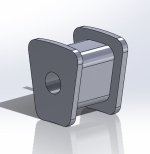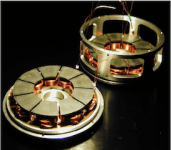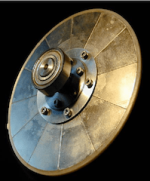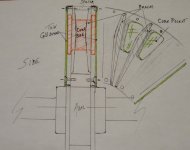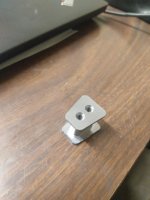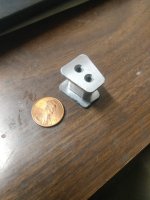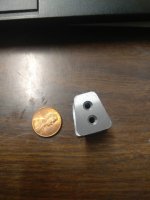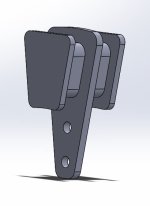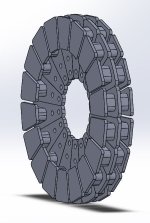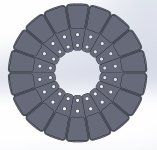The segments need to be in contact for sure, I don't think overlap is necessary. I had the thought of making the holes
in the center iron ring 'short slots', so that the cores can all be slid inward slightly, to allow them to make hard contact
with each other, before tightening down. The steel ring will further connect the flux path.
(might even be able to get by with just one small center hole)
18/16 needs to have a diameter, and a pole length. Things are moving faster than I can draw! But heres a drawing of a
8" diameter stator, with 40mm cores. They turn out to be 40mm H., 20mm W., by 30mm W. top. With 2 -3mm gaps.
Not precise, but not far off either. (8" stator results in a 9 -9 1/2" motor, which is all that will fit in my bike, and a good
size for a hub motor.)
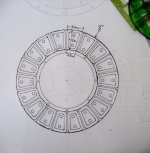
(Looks like your new rendering is this size already)
Dual stator design is actually a single stator, but in two pieces, the cores on each side of the center iron are wired as one
coil. The center iron is just a way to hold the cores well. At least thats the way I see it. Different combinations are possible
with this design.
There will need to be holes in the axle flange for the wires of the coils to go between, for both sides.
It's a dual rotor motor, which is an out runner, and a more bicycle friendly design. It can be a hub motor, or a mid drive.
Holding the cores solid, with the least amount of material, easiest construction, and lightest method is the tricky formula.
At the moment, the center ring is looking pretty good, but I'm not completely sure about weight, I have to do some tests.
Probably going to be close enough though.
The new rendering you have is awesome, I like it a lot, and I really wish that it could be done, it would be nice to put an
aluminum ring on both sides of that and bolt it down. But I fear that the strength of this powdered iron isn't up for it, and
I'm not sure that even winding wire on them will go very well, or bolting them down. This stuff is really crumbly.
Which is why I'm thinking some kind of resin dip, to re-inforce a bit, and insulate for copper. Not much, but would help.
Just my opinion, correct me if I'm wrong. Keep up the awesome ideas, your really good at it!



